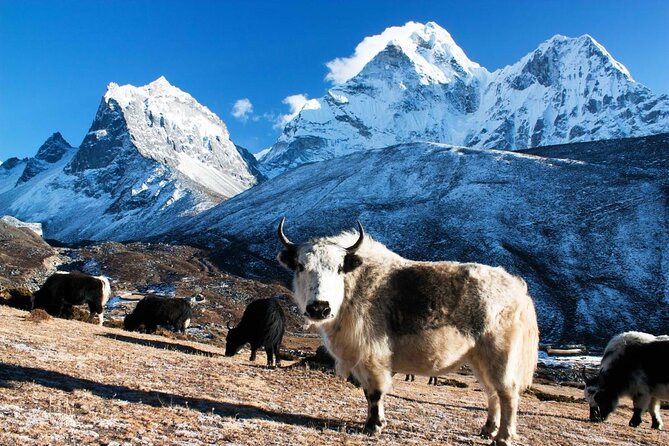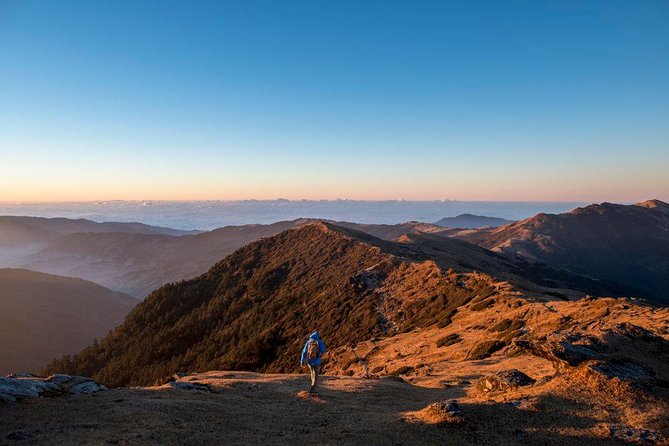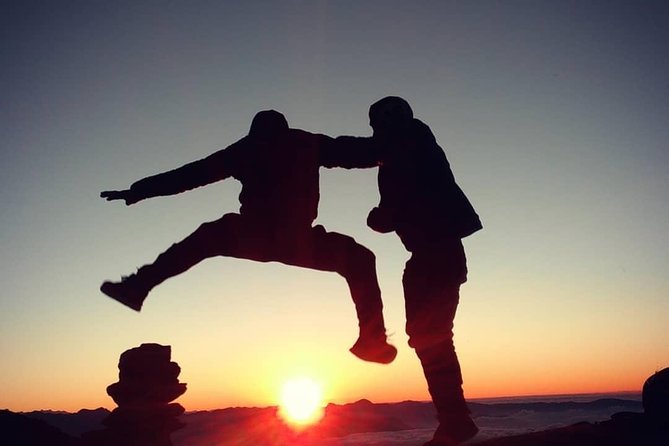Pikey Peak Trekking
Nestled amidst the majestic Himalayas lies the intriguing Pikey Peak Trekking trail, a haven for adventure enthusiasts seeking a harmonious blend of excitement and serenity.
From the initial steps taken on this journey, travelers are welcomed by a tapestry of landscapes that paint a picture of nature’s grandeur. But what truly sets this trek apart is the promise of a unique experience, where every twist and turn unveils a tale waiting to be discovered.
Prepare to be captivated by the allure of Pikey Peak as you venture into a world where tranquility and thrill converge seamlessly, offering a glimpse into the wonders that await.
Key Points

- Breathtaking views and moderate difficulty trekking trail in the Himalayas
- Encounter wildlife like Himalayan Thars and pheasants
- Taste local cuisine for a culture experience
- Blend of natural beauty, wildlife, and culinary delights
Trekking Route Overview

Embark on the scenic Pikey Peak trekking route, known for its breathtaking views and moderate level of difficulty suitable for adventurers seeking a memorable mountain experience.
Along this route, trekkers may encounter various wildlife species such as Himalayan Thars, pheasants, and maybe even the elusive snow leopard. The trail also offers opportunities to taste delicious local cuisine, allowing trekkers to enjoy the culture and flavors of the region.
From traditional Sherpa dishes to locally brewed chang (millet beer), hikers can refuel with authentic meals while enjoying the stunning landscapes. With the perfect blend of natural beauty, wildlife encounters, and culinary delights, the Pikey Peak trekking route promises an unforgettable adventure for those seeking a unique Himalayan experience.
Best Time to Visit

For travelers planning a visit to Pikey Peak, understanding the best time to explore this picturesque trekking route is essential for a rewarding experience. The timing of your trek can significantly impact the weather conditions, visibility, and overall enjoyment of the journey.
Here are some key points to consider:
-
Peak Season
-
Spring (March to May) and Autumn (September to November) are the busiest months.
-
Clear skies offer stunning views of the Himalayas.
-
Accommodation and facilities may be crowded but more available.
-
Off Peak Months
-
Monsoon season (June to August) brings heavy rainfall and limited visibility.
-
Winter (December to February) can be cold with snow, making trekking more challenging.
Required Permits and Fees
When planning a trek to Pikey Peak, travelers must ensure they obtain the necessary permits and be aware of associated fees to comply with local regulations.
Permit regulations dictate that trekkers need to acquire the Khumbu Pasang Lhamu Rural Municipality Entrance Permit, which costs around NPR 2,000 (approximately USD 17). Plus, the local community is actively involved in managing the area, and part of the fees collected goes towards supporting the community’s development projects.
It’s essential to respect the permit regulations not only to abide by the law but also to contribute positively to the local economy and infrastructure. By obtaining the required permits and paying the associated fees, trekkers can enjoy the breathtaking landscapes of Pikey Peak while supporting the surrounding communities.
Accommodation Options

Wondering where to stay during your Pikey Peak trekking adventure? When trekking in this beautiful region, you have a variety of lodging choices and camping alternatives available to suit your preferences and needs:
-
Teahouses: These are popular among trekkers, offering basic amenities and a cozy atmosphere.
-
Homestays: Experience local hospitality by staying with families in the villages along the trekking route.
-
Tented Camps: For those who prefer a more adventurous experience, camping under the starlit sky is an option.
-
Guesthouses: Found in some villages, these provide a comfortable stay with local charm.
Choose the option that aligns best with your trekking style for a memorable Pikey Peak experience.
Packing List Essentials

As you prepare for your Pikey Peak trekking adventure, ensuring you have the essential items on your packing list is key to a successful and comfortable journey in this stunning region. When packing for your trek, make sure to include essential gear such as sturdy hiking boots, warm layers, a waterproof jacket, a headlamp, a first aid kit, and a reusable water bottle. Plus, don’t forget to pack some snacks to keep your energy up while on the trail and to experience the local cuisine. Embracing the flavors of the region can enhance your trekking experience and provide a taste of the culture you are exploring. Here’s a helpful table to guide you:
| Essential Gear | Local Cuisine |
|---|---|
| Hiking boots | Local tea |
| Warm layers | Dal Bhat |
| Waterproof jacket | Sherpa stew |
Safety Tips for Hikers
What essential safety tips should hikers keep in mind while embarking on the Pikey Peak trekking adventure?
Hikers must prioritize emergency preparedness, ensuring they’ve a first aid kit, extra food, water, and a map.
It’s crucial to follow trail etiquette, yielding to uphill hikers and being mindful of wildlife habitats.
Weather considerations are key; hikers should dress in layers, carry rain gear, and be aware of changing weather patterns in the mountains.
Encountering wildlife is a possibility, so it’s important to make noise while hiking, carry bear spray if applicable, and know how to react calmly if faced with wildlife encounters.
Cultural Experiences Along the Trail
Visitors trekking along the Pikey Peak trail can enjoy a rich tapestry of cultural experiences, encountering traditional Sherpa villages, Buddhist monasteries, and local customs that offer a glimpse into the vibrant heritage of the region.
Along the trail, hikers can indulge in the authentic flavors of local cuisine, tasting dishes that have been passed down through generations.
Plus, they may have the opportunity to witness traditional dances performed by the Sherpa community, showcasing their unique rhythm and storytelling through movement.
These cultural encounters provide a deeper understanding of the people who call this region home, adding a layer of richness to the trekking experience that goes beyond the stunning natural landscapes.
Common questions

Can I Bring My Own Trekking Gear or Is It Available for Rent at the Starting Point?
When considering trekking adventures, travelers often ask about bringing their own gear or renting equipment at the starting point. It’s essential to check beforehand to ensure personal preferences align with available gear rental options for a smooth excursion.
Are There Any Specific Dietary Restrictions or Considerations to Keep in Mind During the Trek?
When planning for the trek, travelers should inform the guide about any dietary preferences or food allergies. This allows for suitable meal arrangements to be made in advance, ensuring a smooth and enjoyable journey without any dietary concerns.
Is There a Limit to the Number of Trekkers Allowed on the Trail at Any Given Time?
Trekking regulations in place typically enforce group size restrictions on trails to maintain safety and preserve the environment. These limits ensure a better experience for all hikers and prevent overcrowding, contributing to a more sustainable trekking environment.
Are There Any Emergency Evacuation Procedures in Place in Case of Unforeseen Circumstances?
In case of unforeseen circumstances, emergency response and evacuation plans are crucial. It’s essential to have protocols in place for swift and efficient evacuation procedures to ensure the safety and well-being of all involved.
What Is the Policy on Waste Management and Eco-Friendly Practices During the Trekking Experience?
When it comes to waste disposal and eco-friendly practices during outdoor experiences, travelers can expect responsible recycling, sustainable practices, and conservation efforts. These efforts aim to preserve the environment and promote a greener approach to tourism.
Last Words
Embark on the Pikey Peak Trekking adventure for an unforgettable journey filled with stunning landscapes and cultural experiences.
With a personalized tour tailored to your group and a moderate level of fitness required, this trek offers a perfect blend of tranquility and thrill.
Explore the wonders of the Himalayan region and learn about nature’s marvels.
Don’t miss out on this enriching escapade that promises unparalleled beauty and serenity at every step.